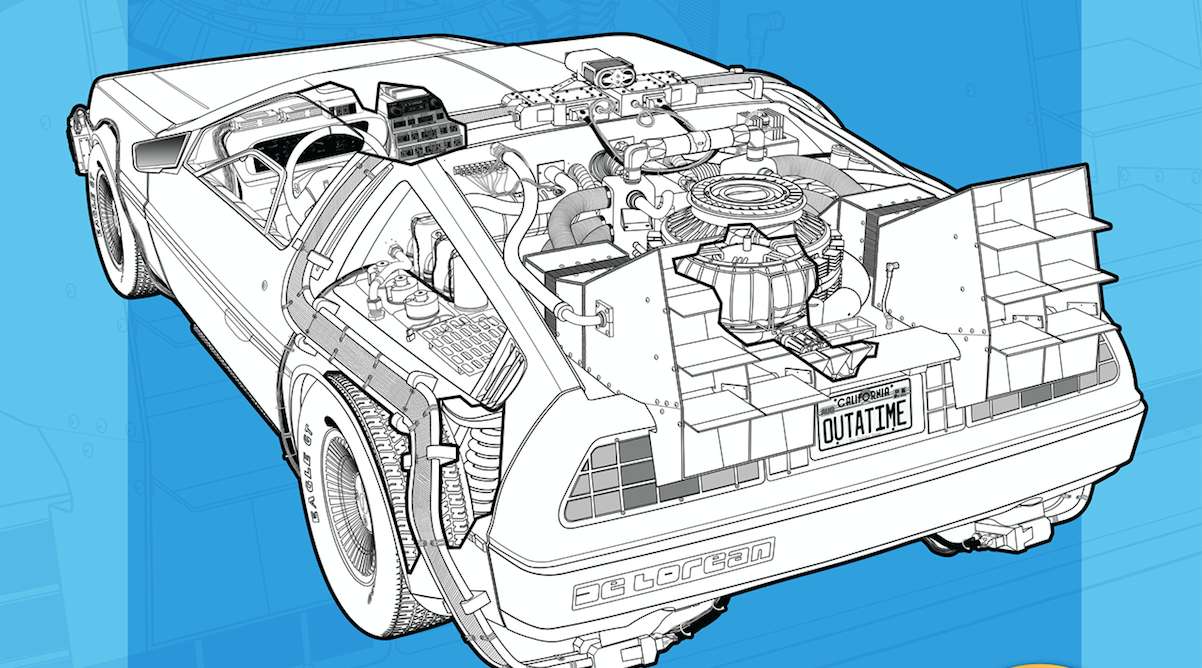Create a free profile to get unlimited access to exclusive videos, sweepstakes, and more!
Back to the Future: New DeLorean Owners' Manual reveals how time-travel disasters are averted

Let's be clear, Back to the Future's iconic time-traveling DeLorean is one of the most recognized hero cars in all of fandom, with its signature gull-wing doors, rear nuclear reactor, and flux capacitor requiring 1.21 gigawatts of power to leapfrog the decades.
Whether in its basic version zooming across the parking lot at the Twin Pines Mall in the original Back to the Future, the converted hover-car in Back to the Future Part II, or the Old West model rocketing down the railroad tracks in Back to the Future Part III, Doc Brown's fantastic machine and its under-the-hood mysteries are deserving of a closer inspection.
Providing a detailed look into the DeLorean's inner workings, Insight Editions is releasing Back To The Future: DeLorean Time Machine: Doc Brown's Owners' Workshop Manual on Mar. 30. — and SYFY WIRE has an exclusive peek to share.
This 160-page hardcover guide is patterned after the classic Haynes automotive repair and maintenance manuals produced by the Haynes Publishing Group since 1960 and covering more than 300 types of cars and trucks.
Insight's revealing guidebook is written by Bob Gale, the Oscar-nominated screenwriter-producer-director who was the co-creator and co-writer of Back to the Future and its sequels, in collaboration with automotive historian and DeLorean expert Joe Walser. Back in 2013, Walser spearheaded Universal Studios' restoration efforts for the screen-used DeLorean seen in all three Back to the Future films, which is now on display at the Petersen Automotive Museum in Los Angeles.
"Even without the time machine aspect, the DeLorean is a beautiful and unique car, capable of turning heads 40 years after the first ones came out of the plant," Gale tells SYFY WIRE. "Now, 35 years after the first movie, the vehicle is so closely identified with the trilogy that it's practically a character and just gives people great memories. Just like you can't look at an Aston Martin DB-5 without thinking of James Bond, despite the fact that Bond has had so many other cars over 60 years."
Gale and Walser have provided loads of intriguing details and little-known functions that fans might not be familiar with regarding the DeLorean's top-secret design. These illuminating options include Doc's numerous modifications like the Flux Capacitor and Mr. Fusion, as well as the car's liquid Freon Emergency Cooling System and the custom algorithms required for the Time Circuits Computer to account for the Earth's rotation.
The DeLorean Owners' Manual also contains dozens of exclusive vehicle schematics and handwritten excerpts from Doc Brown's personal notebooks, which explain his life following World War II, how he came to the decision to build a time machine, his first journey into the year 2015, and how he survived his accidental hop back to the Old West of 1885.
"Every component now has a name and a clear function," Gale adds. "For example, those 3 hockey puck things are the Particle Accelerator Canisters, and the book explains how they relate to the nuclear reactor. And for those who don't know, the wicked looking exhaust vents are actually the equivalent of cooling towers at a nuclear plant. But I think the most exciting aspect is that the car tech stuff is tied together with excerpts from Doc Brown's handwritten journals."
As to Gale's favorite version of the Back to the Future DeLorean, he claims it has to be the nuclear car.
"That was the original design, and that's how it's introduced, and every time I see the first movie, I get a little tingle when it rolls out of the back of Doc's truck," he reveals.
Insight Editions' Back To The Future: DeLorean Time Machine: Doc Brown's Owners' Workshop Manual arrives Mar. 30.






























